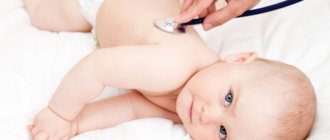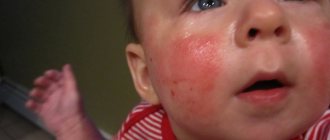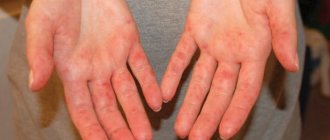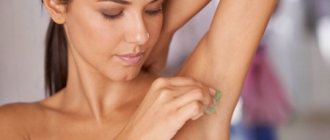Causes of rashes in children
The rash can have different origins. Most rashes in newborns are accompanied by a mandatory diet for the nursing mother. If this does not help, the child may be switched to artificial feeding with a mixture containing split cow's protein. In reality, allergic reactions in infants are rare. They are the ones who require the mother to diet or switch to a hypoallergenic milk formula.
The most common rash is erythema toxicum neonatorum. It may appear immediately after birth or on the second day. Neonatologists explain it as a reaction of the skin to the colonization of the intestines by beneficial bacteria. This rash does not require any special care or treatment, because it goes away on its own after a few days. Rarely rashes persist for up to 3 weeks.
Infectious pathologies in infants
Children, like adults, are susceptible to infectious infections that affect the condition of the skin. Among them:
- herpes;
- staphylococcal pemphigus;
- candidiasis;
- scarlet fever.
The herpes virus can be in the body and not manifest itself in any way until the immunity is significantly reduced. Staphylococcal pemphigus and candidiasis are most often acquired by the newborn from the mother during passage through the birth canal.
Atopic dermatitis
This skin lesion is explained by genetic predisposition. The skin loses its barrier function, becomes dry and itchy. More than 30% of cases of atopic dermatitis are closely related to food allergies, which manifest themselves after consuming a certain set of foods, these are:
- cow's milk;
- egg white;
- nuts;
- wheat.
A distinctive feature of this type of dermatitis is the absence of lesions in the folds - it appears on convex surfaces. Most often, a rash occurs on the child's forehead.
Atopic dermatitis
Attention! Atopic dermatitis very rarely occurs in newborns and infants younger than three months.
Diaper dermatitis
From the name of the type of inflammation it follows that a problem occurs with the skin where the child comes into contact with the diapers. Modern infants come into contact with diapers. Hygiene items have changed, but the name of the disease remains the same. The essence of skin inflammation lies in:
- skin contact with an overfilled or poor-quality diaper;
- poor rinsing of bed linen and children's clothing;
- coarse synthetic fabrics from which children's clothes are made.
Treatment most often comes down to teaching parents to change the diaper on time, wash the baby's skin with clean water and lubricate it with a simple baby cream based on Vaseline or containing zinc.
Rashes due to microclimate
A rash on the face and head of a month-old baby often appears not because of any special bacteria or fungi, but because parents do not maintain cool and humid air. The baby's head, especially covered with thick hair from birth, sweats intensely if the room where the baby sleeps is hot and dry.
Additional Information! You can observe an exacerbation of rashes on the face or back of the head immediately after sleep. When a child sleeps in a hot and unventilated room, the sweat glands work actively, the skin rubs against the bedding, which causes irritation.
Food allergies
The liver of a small child is still immature, so not all foods can be included in complementary foods. Pediatricians and nutritionists have a special attitude towards sugar. They do not recommend that parents additionally sweeten cereals and compotes, and also ask them not to rush into introducing juices and sweets into the diet.
Every adult has seen in their life a baby with a rash on the forehead, nose, cheeks and chin. This is a typical manifestation of food allergies.
Diathesis
Hormonal imbalance
Dermatologists see many patients who have been visiting cosmetologists and beauty salons for a long time. Especially after acne treatment. They complain: they did so much cleaning, spent so much money, but the acne was still there!
A cosmetologist solves an important problem - removes sebum from the glands, explains Dr. Navrotsky. “This has an effect: the skin becomes cleaner, but only temporarily. Because acne is a chronic multifactorial disease that is strongly related to hormonal levels.
The skin becomes oily and covered with acne when the body has a high level of male sex hormones (androgens) - they stimulate the production of sebum and, if there is excess, it stagnates. Plugs (comedones) appear, an inflammatory process begins in the sebaceous gland, pyogenic microbes join in - and here you have an area of inflammation - an acne, an abscess.
An excess of male sex hormones, as well as a violation of the synthesis of thyroid hormones, often provoke hair loss.
In practice, there are often cases when, due to high levels of androgens, young men begin to go bald at the age of 18, the doctor shares his experience.
Hormonal imbalances need to be corrected taking into account the opinion of an endocrinologist. And if you keep the disease under control, both the condition of your skin and hair will improve.
Symptoms and types of rashes
In order to figure out why a rash appeared on the head or body of a baby, you should remember all the events that preceded it, which may include:
- using a new detergent;
- buying new synthetic clothing;
- walking with a child in the hot season using a synthetic carrier;
- the mother of a breastfeeding child happily ate three oranges;
- Grandmother made delicious tea with condensed milk for the baby.
These are all common causes of rashes in children. In addition, if the rash has clear boundaries, each pimple contains a white head that becomes larger every day and then dries, it is most likely a bacterial infection.
Important! Pediatricians distinguish a bacterial infection from an allergic reaction by the appearance of the rash. As a rule, the presence of a white head on pimples indicates the presence of pus under the skin, which most often occurs as a result of the development of a staphylococcal infection.
A rash behind the ears in a child, spreading over the scalp, which is accompanied by severe peeling, may be seborrheic dermatitis. This condition is similar to dandruff in adults. By analyzing the fallen off crusts, the doctor will make an accurate diagnosis and prescribe treatment.
Severe stress
It often manifests itself as hair loss, or alopecia, as doctors call it. Recently, there are more and more patients with thinning hair, says the specialist.
A year ago I was counseling a girl,” he says. — A 6 by 7 cm area formed on her crown, where hair was completely absent. They fell out in just a few days when she quarreled with her fiancé and was very worried about it.
Why is this happening?
Hair needs nutrition, explains the dermatovenerologist. - Each hair receives it through the vessels that approach the hair follicle. When psycho-emotional stress occurs, vasospasm occurs, and as a result, the hair does not receive what it needs, weakens and falls out.
Fortunately, in most cases, hair loss after stress is a reversible process. By restoring psychological balance and using external means that stimulate the hair follicles, as a rule, it is possible to resume hair growth.
What to do if a rash appears
Sensible parents, at the first appearance of a rash on the face and head of a newborn, will consult a doctor. If they are sure that the rash appeared after sleep, when the mother was afraid to open the window and ventilate the room in the evening, they can do without medical help. It will be possible to bring the skin back to normal using water procedures and adjusting the microclimate of the room.
Prohibited actions when caring for an infant
If a mother decides to independently treat her baby, she should not forget that there are actions that should not be performed:
- squeeze out pimples;
- try to remove flaky skin using special hard washcloths;
- without doctor's recommendations, experiment with hormonal ointments and antibiotic-based products.
Taking medications
Taking the simplest and most harmless, at first glance, medications can cause a protest from the skin. Thus, in the practice of Alexander Navrotsky, there was a case when a young healthy guy developed a small bluish spot in the same place - on his right shoulder, when he took analgin to relieve tooth pain. True, only a doctor could establish this connection.
Antibiotics, especially tetracyclines, such as doxycycline, can provoke a negative skin reaction. These drugs have the ability to increase skin sensitivity to sunlight. And if you take them and go out into the open sun, you can get severe burns.
The guy and the girl came in after a weekend vacation on the Minsk Sea,” the doctor tells a case study. Both were taking doxycycline to treat chlamydia. Apparently it was cloudy, and the doctor didn’t tell them not to sunbathe. And then again, it’s hot. We spent a day lying on the beach and got a severe burn, despite the protective cream against ultraviolet radiation.
Any medicine can cause an allergic rash in a particular person, and, alas, it is impossible to predict this. And you can get rid of the rashes only by stopping the drug.
Dr. Komarovsky about rashes in babies
There is a special type of rash characteristic of children from 6 months to 2 years. First, the child develops an elevated body temperature, the range of which varies from 37.5˚C to 38.5˚C. It persists for 3-4 days and is not accompanied by other symptoms characteristic of ARVI: there is no cough, runny nose or weakness. On the day when the temperature returns to normal without any treatment, a small red rash appears on the back, shoulders and neck. It doesn't itch and doesn't bother you. The cause of this condition is a type of herpes - sudden exanthema.
Evgeniy Komarovsky, sharing his experience, reports that, despite the obviousness of the detection, this diagnosis is rarely made to children. The reason for the phenomenon lies in the parents - the average mother cannot simply look at a child with a fever and not use antipyretic medications. Therefore, according to the mother, the following picture emerges: the baby’s temperature rose, from which the mother gave antipyretic syrup, after which a rash appeared on the body. There is an allergic reaction to the components of the drug. It is this entry that is most often found in children's medical records.
Methods and means of hair restoration after loss: evaluation of effectiveness
Fungal and viral skin diseases can also cause hair loss. Such diseases include, for example, viral skin diseases, ringworm, trichophytosis, microsporia and others.
- Decoction of medicinal herbs. Grind 2-3 large burdock leaves, pour a liter of water over the resulting mass, put on fire, and bring to a boil. Then reduce the heat and simmer for 5 minutes. Cool the resulting broth and strain. After washing your hair with shampoo, rinse it with the resulting decoction. A similar decoction can be prepared from nettle, it is no less useful. It is recommended to carry out such rinses 2-3 times a week for 2 months.
- Restorative mask. Mix one tablespoon of honey, aloe juice and chopped garlic. Add egg yolk. Divide your hair into strands and rub the resulting mixture into the scalp. Then cover your head with plastic and a towel. Keep the mask on for 20–30 minutes. It is recommended to carry out the procedure 2 times a week for 2 months.
Only a specialist can decide which hair restoration procedure is right for you. Contact an experienced trichologist for a detailed consultation.
Dangerous consequences
Advanced cases of skin inflammation in infants can lead to scars that will last a lifetime. A rash similar to urticaria, significantly worsening after each meal and accompanied by itching, may indicate fermentopathy. This phenomenon occurs when the liver and pancreas do not produce enough enzymes, causing any food to cause rashes because it cannot be digested. With this type of rash, it is necessary to examine the digestive organs in detail in order to begin restoring the functions of important internal organs as early as possible.
The most dangerous rash is the one that does not look like pimples, but like small hemorrhages. If you press on such redness with your finger, it will not lighten. This is a sign of meningococcal infection, which is very dangerous due to its consequences for the brain and life of the child. As soon as such a rash appears, you need to rush to the hospital, the hours are counting.
Gastrointestinal problems
If you have poor digestion, then most likely, nutrients and vitamins are poorly absorbed. Accordingly, the skin and hair do not receive enough of them. Poorly digested food can even become an allergen for the body. For acne, hair loss, or other rashes on the body, Alexander Navrotsky advises to definitely examine the gastrointestinal tract and treat gastritis, colitis and other diseases. Otherwise, you will have bad skin and hair for the rest of your life.
I recommend getting tested for Helicobacter pylori, a microorganism that causes gastritis and ulcers, even if you are not bothered by stomach pain or heartburn, says the dermatovenerologist. — Helicobacter pylori is easily transmitted through saliva and dishes; the whole family often becomes infected with it. In the last six months alone, I have had several patients with severe acne and dermatitis of the perioral area: after a course of treatment against this microorganism, the rashes decreased or completely disappeared - both in a young girl and in a 70-year-old grandmother.
In general, infectious inflammatory processes in any organ, according to the doctor, can negatively affect the skin - in the form of a rash or hair loss, changes in nails. Often people lose hair after suffering from pneumonia or other inflammatory diseases, and after complete recovery, hair thinning stops.
Preventive measures
It is easier to prevent any disease than to treat it. Therefore, preventive measures can be considered:
- keeping the children's room in order;
- daily hygiene procedures;
- use of clothing and bedding for the child only from natural and breathable materials;
- use only high-quality diapers;
- treating the child’s skin, especially the bottom, after each bath with a cream without dyes or fragrances;
- careful approach to complementary feeding, following the recommendations of the World Health Organization.
Healthy baby
Attentive attitude to the child will allow you to detect the causes of changes in the skin in time. For example, a rash localized only on a child’s ears most likely indicates that the baby is teething - children often grab their ears when they experience discomfort due to pain in the jaw. Dangerous skin problems are extremely rare, but redness due to a child sweating or eating an adult product is not at all uncommon. The awareness of parents can eliminate most rashes.
Diagnostics
The rash is a symptom of a large list of diseases, so it is quite difficult to make a diagnosis based on visual examination alone. To get a complete picture of the disease, the doctor will prescribe a series of tests. For example, if you suspect allergic dermatitis, you will need to donate blood for antibodies to identify the types of allergens.
You may need more detailed information about the baby’s health - an electrocardiogram, an ultrasound of the abdominal cavity, a coprogram to detect dysbacteriosis. Based on the results obtained, a treatment regimen is developed taking into account the age and individual characteristics of the child.
READ ALSO: Black spots on the sternum and nipples in women
Treatment of fungal skin diseases
Treatment of pityriasis versicolor is based on the use of special antifungal ointments and creams. In case of severe skin irritation, antiallergic drugs are prescribed to help relieve itching and reduce redness of the skin.
Drug therapy is carried out under the supervision of a dermatologist, who will select effective drugs with minimal side effects. For severe peeling of the skin, daily use of special shampoos containing ketoconazole is recommended.
Seborrhea responds well to drug therapy in combination with restorative procedures. To eliminate the cause of the disease, antifungal drugs are prescribed, which are selected based on the results of bacterial culture. To strengthen the immune system, the doctor will prescribe vitamins.
READ ALSO: My care for problem skin with La Roche-Posay
Caring for your child during treatment
- It is necessary to ensure that the child does not scratch the rash and pimples. This will avoid complications due to infection of damaged skin. Babies' nails should be cut short; children in their first year of life can wear special "anti-scratch" mittens.
- To bathe a child, you can use a decoction of chamomile, string, and nettle. These herbs have anti-inflammatory properties and soothe irritated skin.
- If the rash is caused by a lack of vitamins, it is necessary to adjust the baby’s diet. Nutrition should be varied and cover the body's needs for vitamins.
Following these simple rules and strictly following the doctor’s instructions eliminates the possibility of complications and reduces treatment time.
News MirTesen










